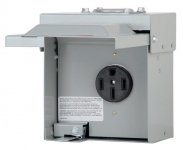NYSUPstater
Well-known member
Am sorry in advance if this is in wrong topic area.
I want to install a 50 amp outlet on outside of garage wall for the RV. Distance from breaker panel/box to outlet location is approx 16'. Know I'll need a 50A dbl breaker and will have to remove the elect drier breaker so that space can be used (no more room for dbl breakers in box). So my question is, what gauge wire do I need given the length of run? Does it come all in 1 casing or all individual wires? Copper or alum? I will not attempt to do this as I'm not that good w/ electrical especially when it comes to 220v, so probly have an electrician do it, just want to make sure he sells me something I don't need.
I want to install a 50 amp outlet on outside of garage wall for the RV. Distance from breaker panel/box to outlet location is approx 16'. Know I'll need a 50A dbl breaker and will have to remove the elect drier breaker so that space can be used (no more room for dbl breakers in box). So my question is, what gauge wire do I need given the length of run? Does it come all in 1 casing or all individual wires? Copper or alum? I will not attempt to do this as I'm not that good w/ electrical especially when it comes to 220v, so probly have an electrician do it, just want to make sure he sells me something I don't need.




